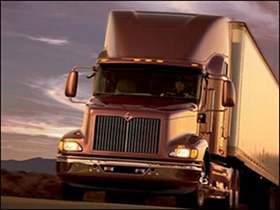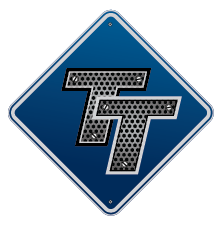Rough Day And Rude Truckers
Topic 16623 | Page 1

Did you hit anything? If not then it's a good day. There will always be times when you are going to run into super truckers and guys that are just a$$hats. You made it into your spot and you didn't hit anything. That's a win in my book and you even learned a new trick to use that's a double win.
Kat gave up:
... and this other driver got in between me and the space I was trying to get into hollering at me to move so he could back in two spaces over. He absolutely would not budge. I ended up having to circle the building and wait behind three other drivers before I could even try again!
Generally, the truck that's "there" first has the chance (or more) to get the job done. Everybody else waits. Almost all drivers have their DOT clocks to worry about, but you should be able to back in, even with some do-overs and pull ups.
Next time, ask Mr Impatient to move out of the way, you'll be done in a minute. Then wait. Don't drive away simply from intimidation. More often, some other driver, as in your try #2, will step up and help out.
I think I went to that Kroger warehouse. Last year there was serious construction, all the trucks had to come in with the docks on the right side (which is the wrong side!) and make blind-side attempts. The experience is still painful!
DOT:
Department Of Transportation
A department of the federal executive branch responsible for the national highways and for railroad and airline safety. It also manages Amtrak, the national railroad system, and the Coast Guard.
State and Federal DOT Officers are responsible for commercial vehicle enforcement. "The truck police" you could call them.
Great advive from Errol. DONT BACK DOWN and stand your ground and make them wait.. Even if it takes you an hour. Your clock is every bit as important as mr impatient's.
In almost two years, I have not encountered many jerks, but rather, lots of helpful drivers like the second one you described. Try to not be discouraged or angered by the occasional louse. If I have a ton of time and can't manage to get backed in, I will make way for someone else, but otherwise, do what you have to do; as Sue D. said, your time is important also.
When drivers rush me I pull the brakes. They can't get around me and realize I'm not moving until they shut up. Either help.me or be quiet.
Don't feel bad. You are learning. And you will get the hang of it. Sometimes I'm not extremely happy when I do it and don't hit anyone. Lol
I did write you..
Kirstenrothlander@gmail.com
Kat; you did the right thing for you. That's most important. You learned some stuff, encountered a GOOD Driver who helped you and the other idiot is gone.
I believe in standing your ground, but sometimes (especially when feeling emotionally drained) you make a decision you can live with.
Hang in there. In time, you'll gain the confidence to act on the others' advice.

I know this is a learning process, and although I ended up at the back of the line, it took some pressure off not having five drivers behind me while I struggled to get it right. The guy that WAS behind me waiting was so nice about the whole thing and made me feel better. I wish I knew how to get those angled approaches right. I gained a few tips last night, but I still worry. LOL Question...do you guys slide tandems all the way back before or after you back into a spot like that? My trainer said that having the tandems all the way back makes it harder to get into a spot, but the guy last night told me always to do that first because it makes the butt end of the trailer easier to guide in.
Found your email, Rainy! Thanks!
Tandems:
Tandem Axles
A set of axles spaced close together, legally defined as more than 40 and less than 96 inches apart by the USDOT. Drivers tend to refer to the tandem axles on their trailer as just "tandems". You might hear a driver say, "I'm 400 pounds overweight on my tandems", referring to his trailer tandems, not his tractor tandems. Tractor tandems are generally just referred to as "drives" which is short for "drive axles".
Tandem:
Tandem Axles
A set of axles spaced close together, legally defined as more than 40 and less than 96 inches apart by the USDOT. Drivers tend to refer to the tandem axles on their trailer as just "tandems". You might hear a driver say, "I'm 400 pounds overweight on my tandems", referring to his trailer tandems, not his tractor tandems. Tractor tandems are generally just referred to as "drives" which is short for "drive axles".
HOS:
Hours Of Service
HOS refers to the logbook hours of service regulations.
I know this is a learning process, and although I ended up at the back of the line, it took some pressure off not having five drivers behind me while I struggled to get it right. The guy that WAS behind me waiting was so nice about the whole thing and made me feel better. I wish I knew how to get those angled approaches right. I gained a few tips last night, but I still worry. LOL Question...do you guys slide tandems all the way back before or after you back into a spot like that? My trainer said that having the tandems all the way back makes it harder to get into a spot, but the guy last night told me always to do that first because it makes the butt end of the trailer easier to guide in.
Found your email, Rainy! Thanks!
If you notice at the testing pad the trainers slide the tandems back before the students test then forward when they go on the road.
Having the tandems back takes more time to turn and compensates for the new drivers tendency to "over steer". Basically the trailer turns more slowly which in theory makes it easier to control. Try it and see how you like it. In tight places it sometimes didn't work for me cause I needed more room for the turn.
You'll laugh, but I still don't really angle. I alley dock almost every door I can't straight back into. Being able to is e where the trailer is going helps me. Then I pull forward to straighten out. I do this at truck stops and o e guy was like " damn you got balls" lol.
The best thing is to get a feel for it and find out what works for you. Try oraxtincing at empty truckstoos during the day. Hell...I've parallel parked like 10 times this week.,. Was told I'd never need it ...yeah u need it in old rest areas and street parking at customers lol
Tandems:
Tandem Axles
A set of axles spaced close together, legally defined as more than 40 and less than 96 inches apart by the USDOT. Drivers tend to refer to the tandem axles on their trailer as just "tandems". You might hear a driver say, "I'm 400 pounds overweight on my tandems", referring to his trailer tandems, not his tractor tandems. Tractor tandems are generally just referred to as "drives" which is short for "drive axles".
Tandem:
Tandem Axles
A set of axles spaced close together, legally defined as more than 40 and less than 96 inches apart by the USDOT. Drivers tend to refer to the tandem axles on their trailer as just "tandems". You might hear a driver say, "I'm 400 pounds overweight on my tandems", referring to his trailer tandems, not his tractor tandems. Tractor tandems are generally just referred to as "drives" which is short for "drive axles".
HOS:
Hours Of Service
HOS refers to the logbook hours of service regulations.OOS:
When a violation by either a driver or company is confirmed, an out-of-service order removes either the driver or the vehicle from the roadway until the violation is corrected.
I prefer to back with my tandems forward. Easier to maneuver in tighter situations. With tons of room to set up having the tandems all the way back does not present a problem. A lot of it is personal preference. Your " landmarks" for backing change significantly with the tandems all of the way forward or all of the way back. Also, you need more room in front of your spot if they are all the wsy back. It takes lots of practice/patience to learn all of this. TIP: The next time you find yourself at one of the giant DC's, with some extra time on your hands, go to a far away corner and practice. Do it with your tandems in both positions. Note your position when you start your setup, count the number of spaces you pull forward, angle of your tractor/ trailer. This will help you to fine tune your setup, and there won't be any A$$hats honking at you and rattling your nerves. Don't worry, you'll get it figured out. PRACTICE every chance you get!

Tandems:
Tandem Axles
A set of axles spaced close together, legally defined as more than 40 and less than 96 inches apart by the USDOT. Drivers tend to refer to the tandem axles on their trailer as just "tandems". You might hear a driver say, "I'm 400 pounds overweight on my tandems", referring to his trailer tandems, not his tractor tandems. Tractor tandems are generally just referred to as "drives" which is short for "drive axles".
Tandem:
Tandem Axles
A set of axles spaced close together, legally defined as more than 40 and less than 96 inches apart by the USDOT. Drivers tend to refer to the tandem axles on their trailer as just "tandems". You might hear a driver say, "I'm 400 pounds overweight on my tandems", referring to his trailer tandems, not his tractor tandems. Tractor tandems are generally just referred to as "drives" which is short for "drive axles".
Dm:
Dispatcher, Fleet Manager, Driver Manager
The primary person a driver communicates with at his/her company. A dispatcher can play many roles, depending on the company's structure. Dispatchers may assign freight, file requests for home time, relay messages between the driver and management, inform customer service of any delays, change appointment times, and report information to the load planners.New Reply:
New! Check out our help videos for a better understanding of our forum features

















Preview:








 TT On Facebook
TT On Facebook
I have been so happy with my backing skills...until tonight at the Kroger warehouse in Houston. Not much room to maneuver and no way to set up for a good straight back so had to angle it in. First set up wasn't quite right, so I pulled forward to try again, and this other driver got in between me and the space I was trying to get into hollering at me to move so he could back in two spaces over. He absolutely would not budge. I ended up having to circle the building and wait behind three other drivers before I could even try again! My second attempt was better but still not right. After more than a half hour of trying, another driver came over and helped me get lined up right. I felt bad for the poor guy waiting behind me. He ended up having even less room to work with. Can't get over how awful some people are. I did learn something though that I hope will make the next time I'm in a tight spot a little easier.